Content Creation Process 101: Tools and Strategies for 2022

This page may contain links to Amazon.com or other sites from which I may receive commission on purchases you make after clicking on such links. Read my full Disclosure Policy
Content creation, especially blogging, is one of my favorite subjects, so I’m excited that Margo Ovsiienko is taking us back to basics with her latest post. She’s got some great tips, whether you’re just getting started or have been at it a while and need a few pointers.

Great content takes time to create and generate traffic online. But once it does, it allows you to receive sustainable and scalable traffic for years to come.
The key is to have a foolproof process that enables you to create content pieces in confidence, whether you want to create blog posts or videos.
This post will break down the process you can use for creating content that will grow your traffic. Also, we will mention the different tools you can use to make the job much easier for you. After all, it is an amateur blogging mistake not to use tools to streamline content creation!
Identify Target Audience
Finding out your business’s target audience sets the foundation of a solid content creation management strategy as it will help you create content specific to that group of people online. Your content can’t cater to everybody because doing so caters to no one.
By zeroing on a segment of your audience, you can create content that they want to read, watch, and listen to. This way, you can build rabid followers who will help spread your message and strengthen your authority in your industry.
For starters, you must first determine the buyer persona or customer avatar of your business, which you’ll refer to when creating your content. It involves narrowing down the demographics and psychographics of the persona.
Your audience’s common age, income, education, interests, and pain points, among others, will comprise your buyer persona.
The goal is to create content that your avatar, whether for B2C or B2B marketing, would want to consume because it represents the majority of your audience. You need to be aware of the cost of marketing a B2B company and take into account the investments you’ll need to make, though.
The same goes for B2C marketing, and identifying your audience will allow you to scale and streamline your spending. This also helps you simplify your content strategy by narrowing down your website’s scope of topics to discuss.
Conduct Proper Keyword Research
Once you have an audience in mind, you can now research keywords your audience searches for.
Finding the right keywords for your website facilitates SEO content writing and makes finding your site online easier and helps even the smallest of businesses to rank on search engines.
There are lots of things to consider when conducting keyword research. First, you want to search for queries that (1) are relevant to your topic and (2) people look for on search engines.
Regarding the first point, you don’t want to cover topics that aren’t relevant to your audience because they simply won’t check them out. If you take a look at some of the most prominent content marketing blogs, you will notice that their content strategies are specialized and niched to serve a unique target demographic.
At the same time, sticking to a niche makes growing your site’s topic relevance much easier. As a result, search engines will consider your website as authoritative if you create content covering everything about a specific niche and rank you higher on search results.
To do this, a quick search on Google of your topic will reveal to you related search terms you can use as article ideas. The fact that Google shows these keywords on search results after searching for your topics means that Google acknowledges the strong correlation between the topic and the related queries. So, by writing about these keywords, you can build stronger topic relevance for your website.
However, searching on Google won’t show you the search volume of the keywords. As mentioned, you want to create content about topics that people search for.
To do this, go to Google Keyword Planner and enter your topic on the search bar. The next page will show you more keyword ideas and suggestions with their corresponding search volume. This helps you identify which keywords to prioritize when creating content for your site.
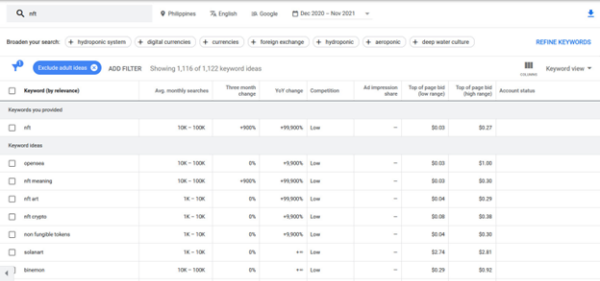
Also, you must strike a balance between high search volume and search intent.
Search intent answers why people searched for the keyword in the first place. Some people use queries to learn more about a topic, while others use specific terms to buy something.
In some instances, it’s better to create content for a topic with clear search intent. These keywords, also known as long-tail keywords, allow you to create particular and targeted content that your audience will enjoy.
At the same time, it’s easier to rank for long-tail keywords due to their low competition. Since most sites are busy creating and optimizing content for SEO with high search volume, making lots of content for long-tail keywords allows you to rank on top and accumulate organic traffic faster.
To help you expedite the keyword research process, use a paid tool like SEMrush. It shows you the search volume of each keyword, their search intent, and keyword difficulty.
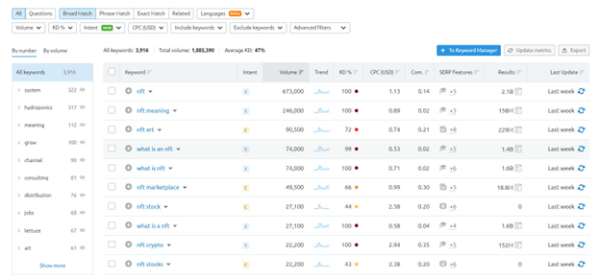
Keyword research is best delegated to a digital marketing agency or an SEO specialist who knows the ins and outs of researching for keyword goldmines. Nonetheless, the process above should give you an idea of how to proceed independently.
Optimize Content for Readers and Search Engines
Once you’ve decided on which keywords to write about, you can begin writing your articles.
Many SEO content tools will help you get the job done, but it’s essential to learn how to write for people, first and foremost. It’s also important to optimize your writing for your audience and the search engines by using tools like Grammarly Premium for spell checking, style corrections, and readability.
Creating content that resonates with your audience requires more than just inserting keywords here and there. It’s all about cleaning up your content writing mistakes and communicating your message without sounding robotic.
Once you’ve covered the human side of content creation , it’s now time to appease the search engines. There are three places where you must include the keyword in your content’s page:
- SEO title
- Page title
- URL
The SEO and page titles can be the same, but you can create unique ones for each using a WordPress SEO plugin like Yoast SEO. The purpose of the SEO title is to help increase the page’s click-through rate once it starts ranking on search results. The page title is the one that appears on the page when your audience visits the page.
Editing the URL to include your keyword is easy, and many branded content agencie s will often choose this route rather than branding the keyword. You can edit it directly from WordPress’s post or page editor or your WordPress plugin of choice.
From here, you need to optimize your content with your target keyword. The old days of ranking on Google search by stuffing in as many keywords as possible in your content are long gone. Nowadays, you have to cover a variety of related keywords within the content to help Google crawl and index the content to the most relevant search terms on SERPs.
To help you achieve this, use a tool like Surfer SEO. Upon entering the keyword, it will provide you with a list of keywords to mention in the article.
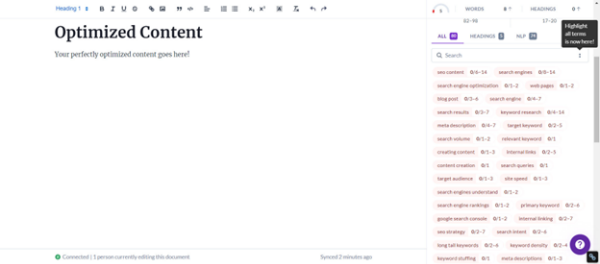
Promote on Different Platforms
After publishing your content, it will take time before search spiders show it on organic search. In the meantime, manually promote your content on your existing channels.
First, share your content with your social media following. The best social media scheduling tool will allow you to schedule your posts in advance and analyze how many saw and clicked on the articles you shared. It also allows your followers to share your content with their network, thus increasing your online visibility and the site’s potential traffic.
If you have an email list, you can also send a short email notifying them about your latest post using your email software of choice.
If your subscribers aren’t receiving your emails for some reason, there may be a problem with your email delivery. In this case, check and see if they have issues you must resolve first before sending emails.
Repurpose Into Different Content Types
To get the most out of the content you created, you can convert them into different content types. For example, you can turn your articles into podcasts or videos, which goes the same for other content types.
Usually, you’d think you need to recreate the content from scratch. However, some tools allow you to recreate the content into different types with just a few clicks of a button. For example, you can convert articles into short-form videos to share on social media using Lumen5.
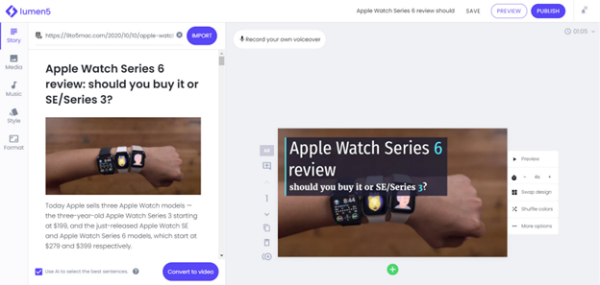
If you want to turn your posts into podcasts, use Play.ht to convert them into audio format with text read by an AI. Using these tools, you may still need a video editing software to tweak the final version to your liking, but they help speed up the process instead of starting from the beginning.
Repurposed content makes for great B2B social media content ideas. For example, you can update the video format of your articles on Facebook or even Instagram to keep a different segment of your audience.
Also, consider revamping your visual content to enhance customer engagement by creating stunning featured images and image quotes for each of your content. You can then share the photos, especially image quotes, to help spread the word about your website.
You can even create a video gallery page on your website to showcase the videos in all their glory as part of your all-encompassing video marketing strategy.
Analyze Results
Over time, you want to see how your content performed.
While analyzing the performance of the content you created isn’t necessarily part of the process, it’s a necessary step to help you understand how your content fared. This way, you can identify blog, website, email, and social media marketing tactics that worked and didn’t, so you can tweak your strategy to improve the performance of your next campaign.
Since you want to track how many people checked out your content and which referral channel they came from, Google Analytics will be the tool you’ll be using to help you make sense of your content. It will show you other metrics such as how long visitors stayed on the page, how many left the site after viewing a page, and more.
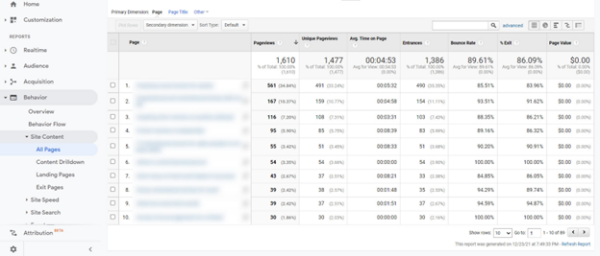
Use the data from the tool to create better content that encourages visitors to read the entire thing and read other posts on your site.
You can also use native analytics tools of platforms like YouTube. From here, you can see which videos received the most engagement from your audience, so you can create the same content type to boost your likes and comments.
Finally, consider monitoring your web pages for connectivity and deliverability issues. This allows you to determine if your site has problems that prevent visitors from viewing your page correctly. From here, you can swiftly make the changes and deliver your content to your target audience.
Photo by Judit Peter from Pexels
Did you find this post helpful?
Share it with your network, and sign up to get new posts by email every week!




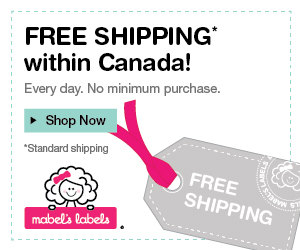






Great article with excellent tools! Thank you
Thank you for stopping by and leaving a comment, Denise!
Margo makes a lot of great suggestions. I know I could do better on so many of these. I have never really gotten into researching keywords. I might need to put this on my list for the future! Thanks for sharing these great tips. 🙂
I love that she explains how to interpret the data so we can make the most of it.
Great tips! I find that Google keyword planner is helpful, and have been using it for years. It is important to do keyword planning before writing, so you pick the right keyword for your time and effort. By doing this, you will manage your blogging time more effectively.
Margo, this advice is stellar. It’s a lot of work, especially for those of us who like to focus on the content and not the content marketing, but you have broken it down in ways that make it all logical and actionable. And this reminds me that I should be doing a much better job analyzing my content marketing methods!